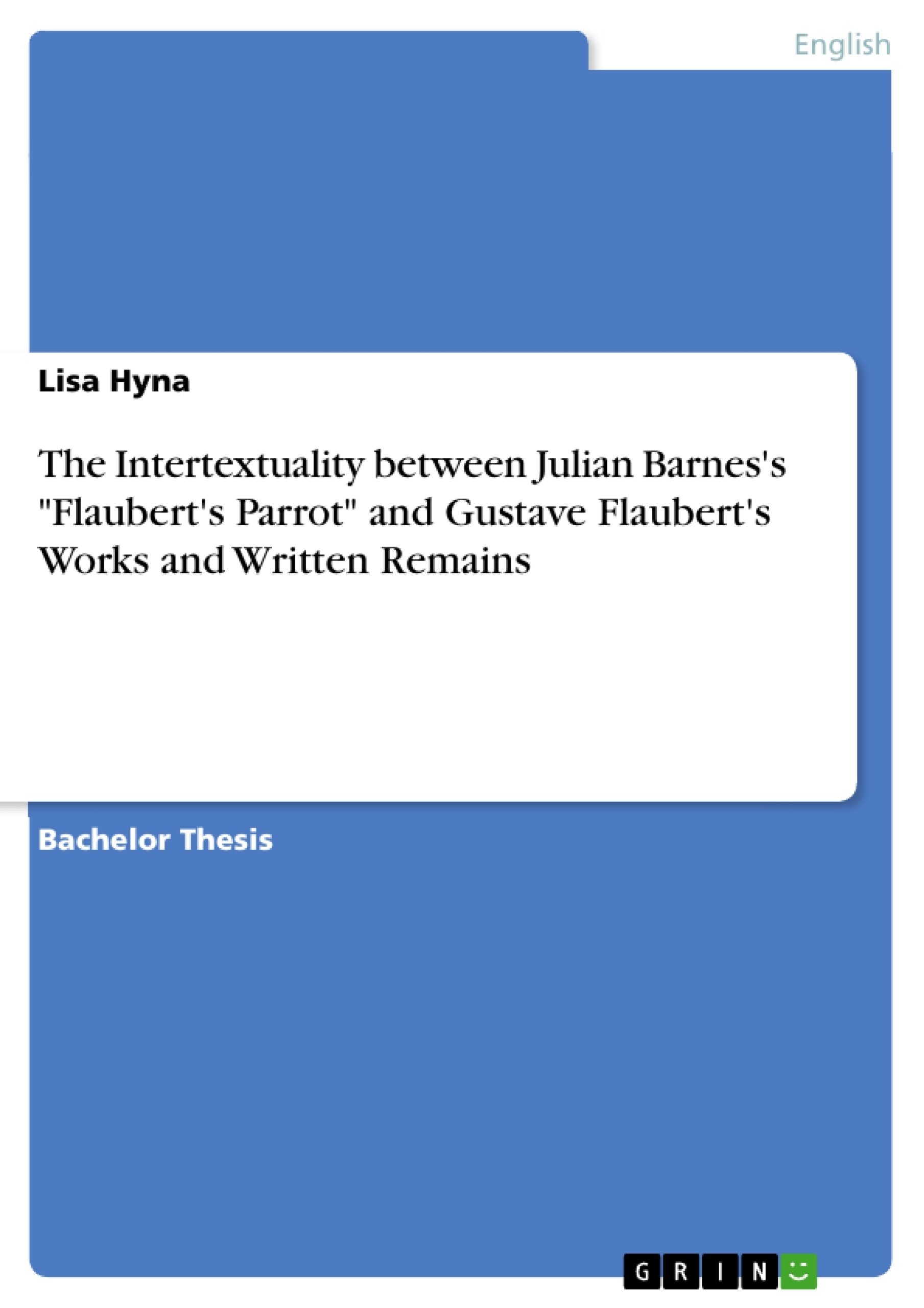The English writer Julian Barnes has developed an experimental style during his writing career, which spans twenty-two novels as well as numerous essays and short stories. His novel Flaubert's Parrot, which was his third published book in 1984, marked an important milestone in his career and shaped his image as an outstandingly talented writer who is fearless of unconventional writing. In the year 2005 Julian Barnes wrote an article in honor of the twentieth anniversary of the book called "When Flaubert took wing" for the Guardian. In that article he described how the idea for the novel came to his mind when he experienced finding two different parrots in Flaubert's hometown, which both claimed to be the original parrot Flaubert worked with. The result was the Booker Prize short-listed novel Flaubert's Parrot. In the novel he merges a postmodern style within a biographical story that is profoundly thought provoking. Neil Brooks described the novel in his comparison to The Good Soldier as "part novel and part criticism of both modern and postmodern theories of textuality". Meanwhile, Barnes presents his impressively extensive research on Gustave Flaubert and incorporates his knowledge into the text in a very entertaining way. Due to its experimental style and unconventional structure the book caused a controversial debate whether or not it is still accurate to call it a 'novel'. The extensive sections that do not follow a coherent storyline and the excursions on literary critical topics complicated the book's classification and categorization into a specific genre. However, Barnes himself claimed that he considers his work as nothing else than a novel. Therefore and due to the fact that different publishers decided to define it as novel as well, this thesis will refer to Flaubert's Parrot as novel, too. After all, literary studies deal with Flaubert's Parrot as a postmodern novel and it has often been categorized within the genre of fictional metabiography. Scholars focused often on the two stories the book offers. Namely, the one story is the search for Flaubert's parrot and the other one is about the main character's past. Both stories are connected through intertextual references that are an interesting issue for literary critics. In particular, the intertextual devices in the novel were often subject for literary studies that aimed to interpret its deeper meaning.
Inhaltsverzeichnis (Table of Contents)
- Introduction
- The Theory of Intertextuality
- History and Development
- Definition and Terminology
- Ulrich Broich's and Manfred Pfister's Application of Intertextuality
- Manfred Pfister's Qualitative Criteria
- Ulrich Broich's Quantitative Criteria
- Julian Barnes's Intertextuality in Flaubert's Parrot
- Intertextuality between Flaubert's Parrot and Flaubert's written remains
- Flaubert's Parrot as Historiographic Metabiography, Biographical Metafiction, or Fictional Metabiography?
- Flaubert's Parrot as Fictional Metabiography
- Intertextuality in terms of Fictional Metabiography
- Intertextuality towards Flaubert's works
- Intertextuality between Flaubert's Parrot and Madame Bovary
- References in the Text
- Emma Bovary's Eyes
- Geoffrey Braithwaite's Search for Ellen
- Geoffrey Braithwaite's Escape from Loneliness
- Geoffrey Braithwaite's Identification with Charles Bovary
- Dissatisfying Ending
Zielsetzung und Themenschwerpunkte (Objectives and Key Themes)
The thesis aims to show how intertextuality has an essential impact on the novel's interpretation and meaning. It will proceed progressively from a general level to a specific analysis of the novel, Flaubert's Parrot. The term 'intertextuality', its history and development, and the theory it designates will be defined, as will the specific terminology and its usage for literary studies.
- The History and Development of Intertextuality Theory
- The Definition and Terminology of Intertextuality
- The Application of Broich's and Pfister's Intertextuality Theory to Flaubert's Parrot
- Intertextuality between Flaubert's Parrot and Flaubert's Written Remains
- Intertextuality Between Flaubert's Parrot and Flaubert's Works
Zusammenfassung der Kapitel (Chapter Summaries)
The Introduction sets the stage for the thesis, presenting the context of Julian Barnes's work and specifically focusing on his novel Flaubert's Parrot. The chapter discusses the novel's experimental style, its controversial classification, and the motivation for this analysis. It highlights the importance of intertextual devices in interpreting the novel's meaning.
Chapter 2 explores the theory of intertextuality, its historical development, and its definition. The chapter clarifies the concept of intertextuality, drawing from the work of Julia Kristeva, Ferdinand de Saussure, Mikhail Bakhtin, and Gérard Genette.
Chapter 3 presents the application of intertextuality theory in literary studies, focusing on the work of Ulrich Broich and Manfred Pfister. It examines the qualitative and quantitative criteria they developed to analyze intertextual relations in literature.
Chapter 4 examines the intertextuality present in Flaubert's Parrot by Julian Barnes. It explores the novel's experimental style, its connection to other works, and how it embodies the intertextual criteria established in previous chapters.
Chapter 5 dives deep into the intertextuality between Flaubert's Parrot and Flaubert's written remains. This includes exploring the novel's genre as fictional metabiography and how it serves as a basis for understanding the intertextual connections. It also discusses the blurred boundaries between fact and fiction in the novel and how they contribute to the intertextual meaning.
Chapter 6 analyzes the intertextuality between Flaubert's Parrot and Gustave Flaubert's works, specifically focusing on Madame Bovary. This includes examining the numerous references to the novel and their impact on the reader's understanding of the characters and themes.
Schlüsselwörter (Keywords)
This thesis explores intertextuality, fictional metabiography, postmodernism, and the impact of Gustave Flaubert's works, particularly Madame Bovary, on Julian Barnes's novel Flaubert's Parrot. It examines how these elements intertwine to create a complex and multifaceted narrative that challenges the boundaries between fact and fiction.
- Citar trabajo
- Lisa Hyna (Autor), 2013, The Intertextuality between Julian Barnes's "Flaubert's Parrot" and Gustave Flaubert's Works and Written Remains, Múnich, GRIN Verlag, https://www.grin.com/document/444237



